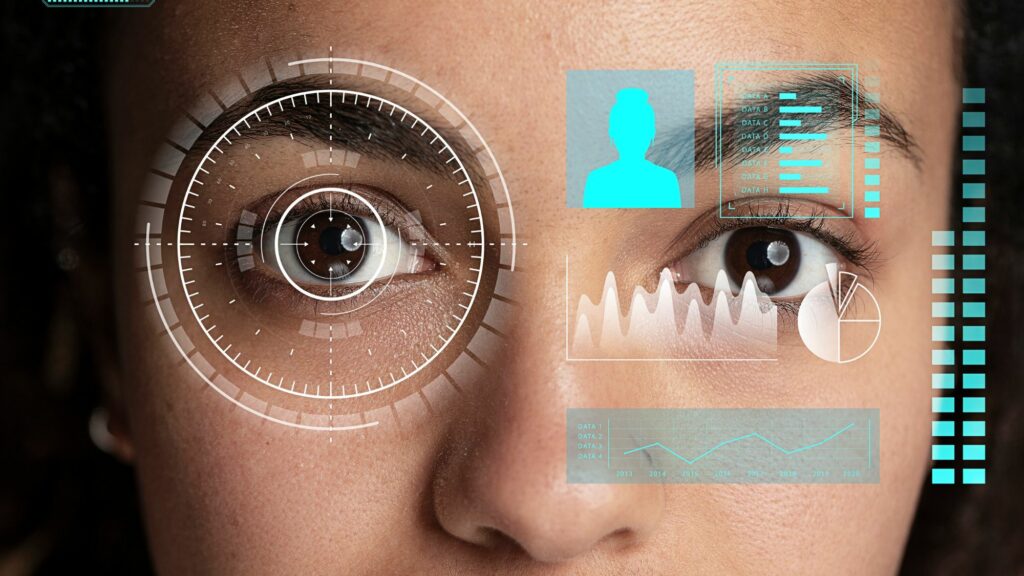Secrets of Modern Surveillance – Facial recognition technology has emerged as one of the most discussed inventions of the 21st century. Whether it unlocks the smartphone, provides public safety, or ensures more efficient monitoring and modern surveillance of populations, FRT is expanding in all industries and sectors with alarming speed. It promises much in the way of convenience and security but raises equally pressing questions about privacy, ethics, and the limits of modern surveillance in modern societies. This paper will continue to analyze the various aspects of facial recognition, its implications on privacy, and the evolution of modern surveillance use.
Introduction to Facial Recognition Technology
What is Facial Recognition? Basics Understanding Facial Recognition Biometric technology maps, analyzes, and compares facial features to identify or verify a person’s identity by capturing an image of the individual’s face and normally digitizes this image often in the form of a facial template, to then match that against known faces within a database for a possible match. Unlike other biometric systems such as fingerprints or retina scans, facial recognition can be done without the cooperation of the individual being recognized. It is thus most suited for modern surveillance.
History of Biometric Identification and Modern Surveillance
Biometric systems are not new to the world and have been used for decades under different names. Indeed, the first facial recognition system was constructed in the 1960s by Woodrow W. Bledsoe, an American mathematician. More important than anything, the breakthrough happened to be that computer vision and AI made dawn in the late 20th century to early 21st century. Machines henceforth improved and displayed enhanced precision and accuracy through the recognition system capable of instant and accurate identity detection in real time.
How Facial Recognition Works
Components of the Facial Recognition System
Majorly, the components include facial recognition systems :
Capture Devices The facial image is captured through a camera or other imaging sensors. These capture devices can be very high resolution in nature, consider modern surveillance cameras or infrared sensors, especially in environments with low lights.
Facial Feature Detection The system picks out and extracts key facial features, like eyes, nose, mouth, and chin. Modern algorithms could extract over 100 features from a facial image, thereby creating a “faceprint” of each person.
Feature Extraction: The facial features detected in this stage are converted into digital forms. A digital faceprint contains the map of the features and is akin to any data set; this faceprint is matched with the database.
Matching Algorithms: The extracted faceprints are matched against databases of known persons with faces. The process is that of matching, but not done with humans like before; instead, these processes rely on algorithms that compute similarities and differences in features.
Algorithms and Artificial Intelligence Behind the Technology
The core of modern Facial Recognition Systems lies in machine learning and AI. Algorithms are trained on large sets of facial images, so they can learn patterns, differences, and similarities at a very high accuracy level. The main technological advancements are:
Deep Learning: DNNs are part of a family of ML algorithms that is a very close analog of the human brain. Using large datasets, one learns both from more instances and from instances with more nuanced facial features. That led to improvements in both precision and speed.
Convolutional Neural Networks: The CNNs are specifically good for image recognition. Networks are created to be visually trained hierarchically which makes it possible for the system to recognize complicated details of the face-like curvature of the nose or even the shape of the eyes.
Transfer Learning: This enables the facial recognition systems to learn from existing models. The system reduces the data required for successful recognition by a trained model on a new dataset, thus making it more efficient and cost-effective.
Applications of Facial Recognition in Modern Society
Security and Law Enforcement
This technology has been extensively implemented by the police to track and identify criminals. Most forces in the world have adopted FRT in scanning modern surveillance videos, identifying criminals, and tracing criminal activity. Other countries have integrated facial recognition systems into public areas, which follow and identify interested persons in real time. This has led to some of the most frequently quoted concerns over possible misuse.
Consumer Electronics and Smartphones
The most prominent examples of consumer electronics using facial recognition is in a smartphone or a personal device. Take Apple’s Face ID which uses infrared sensors and algorithms, based on machine learning that can create 3D mapping for the users. The same technology that is not only able to lock but is also going to authenticate and give access permission through apps related to banking, or even those where people have the facility to shop online.
Workplace and Access Control
Companies use facial recognition for employee identification and access control. Companies can easily deny unauthorized access and simplify security by linking the facial scans with the employees’ credentials. Employees need to scan their faces for check-in and check-out processes in some companies using time-tracking systems supported by FRT.
Public and Private Sector Use Cases
Public and private sectors have witnessed FRT become the norm of the day. Public facilities such as airports, train stations, and stadiums use FRT to manage the crowds, collect tickets, and ensure safety. Retailers utilize FRT to identify the demographics of their customers to conduct the right marketing strategy. Banks secure their banking service through FRT
Facial Recognition in Modern Surveillance
Public Safety or Fading into the Background?
The merit of FRT would be justified by its potential for an upgrade of public safety. It is within this perspective that governments and their security wings will justify FRT for quick identification of criminals, tracing missing persons, tracing terrorists and social engineering attacks. On the other hand, critics will argue that widespread modern surveillance will turn society into a “Big Brother” where each activity becomes recorded and tracked.
Real-time Monitoring and Data Collection
Facial recognition systems would enable people to be monitored in their activities which is a privacy concern. Using cameras in cities has made following people’s movements much easier, without their knowledge and consent. Such mass surveillance may make life private and private and liberty no system.
Mass Modern Surveillance and Issues of Privacy And Ethical concerns
Mass Modern Surveillance and Data Breach
The biggest concern in using facial recognition technology is mass modern surveillance. The authorities may track the movement, behavior, and activities of citizens, thereby depriving them of their right to privacy. Facial recognition data is also sensitive; thus, breaches in these databases could lead to identity theft or malicious activities.
Security vs. Individual Rights
Facial recognition is a challenge that balances safety advantages with an individual’s rights. However very resourceful for use in advancing safety and preventing crime, in no way will it end the use thereof on someone’s simple right to the in violation of privacy over an individual’s personal life. There is then need for these regulations to be enunciated explicitly lest become misconstrued.
Facial Recognition and Law: Comparative Perspective
The use of facial recognition technology is controlled by laws and regulations that differ from one country to another. In the United States, it is a patchwork of local and federal laws and some cities have banned it altogether. The European Union has been more proactive and has placed controls on the use of biometric data through the General Data Protection Regulation (GDPR).
Accuracy and Limitations of Facial Recognition
False positives and negatives: how reliable is the tech?
The facial recognition technology is not infallible. It has the probability of false positives-wrongly associating a wrong person with a criminal-as well as failure to identify people, which sometimes has severe results. Although with time, technology has advanced, in certain situations, the technology has flaws, such as in identifying people wearing masks or in dim light.
Bias and Discrimination in Recognition Systems
Another significant weakness of facial recognition is the algorithmic biases. Facial recognition systems do not identify racial and ethnic minorities as well as women and younger individuals to the same level of accuracy as the dominant group; hence this has a greater misidentification rate. Such a bias aggrieves the current inequalities and continued systemic discrimination, particularly in policing.
The Future of Facial Recognition Technology
Emerging Innovation
The future of facial recognition most probably belongs to AI and machine learning. New algorithms and techniques, such as 3D facial recognition and emotion detection, are emerging. These developments may enable systems to be more accurate and efficient under diverse conditions.
Role of AI and Machine Learning in Facial Recognition Advancement
The advancements in AI and ML will further advance the capacity of facial recognition. In this aspect, FRT will be enhanced in terms of accuracy, speed, and minute details of face analysis to enhance the reliability in identification further.
International Responses by Regulations to Facial Recognition
Legal and Regulatory Provisions for Its Application
Different nations approach facial recognition technology differently. In the case of the European Union, handling biometric data is strictly under the guidance of the GDPR. In the United States, the regulation does not have a federal, broad general law regarding these matters and relies on local entities to define policy. China has one of the most advanced facial recognition systems, and this raises questions of whether there is ever a form of state control vs. personal liberty.
Case Studies: Countries and Cities Banning or Restricting Facial Recognition
Many countries and cities have banned the use of facial recognition technology for privacy and ethical reasons. San Francisco was the first major U.S. city to ban its use by its city agencies. The UK discussed using FRT among law enforcement for benefits over mass modern surveillance.
Facial Recognition in the context of Security and Modern Surveillance
Improve National Security and Counter-Terrorism Policies
Facial recognition plays a significant role in improving national security. This technology enables law enforcement agencies to track terrorists and criminals as they surveil huge populations at airports, train stations, and public forums.



